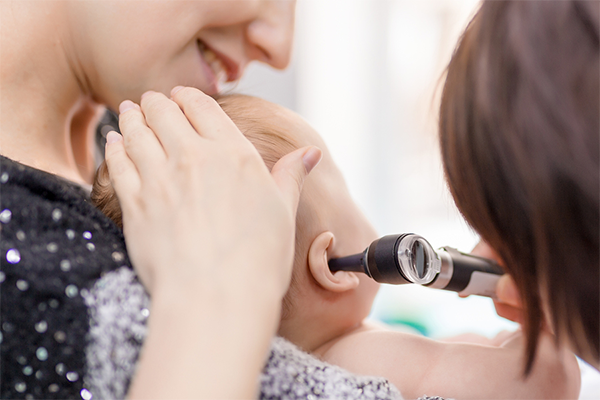Sleepless nights. Fussing while feeding. Tugging at the ear. And crying when lying down. Yep, your child has the classic signs of an ear infection.
For toddlers around ages 1 to 2, ear infections are as common as the common cold, and anatomically, there’s good reason. “In kids, the tube that connects the ear to the back of the nose—which is called the Eustachian tube—is shorter and more horizontal than in adults,” said Dr. Drew Prosser, an ear, nose and throat surgeon at the Children’s Hospital of Georgia. “As a result, it’s easier for bacteria to travel from the nose into the ear and precipitate an infection.”
And during cold season—in other words, right now—upper respiratory infections and resulting inflammation can lead to swelling that prevents fluid from draining from the ears, making the likelihood of an ear infection even greater.
Does My Child Need to Have Tubes?
That’s probably one of the most common questions parents ask their pediatrician or ENT specialist. The good news is that the answer, most likely, is no. But there are many questions that parents don’t ask about ear infections, but should. Here are a few of the most common:
What’s the best way to clear the fluid from my child’s ear(s)?
Instead of the ear, look elsewhere: the nose. Saline drops are very helpful in thinning out mucus, which decreases inflammation and helps bacteria and fluid wash out of the ears (and if you really want to know, this fluid then washes into the back of the nose and is swallowed). If your child has a stuffy or snotty nose, just try a couple of drops at a time—and if you like, you can follow that up with gentle suction using the classic blue bulb or a nasal aspirator.
Is there still fluid in my child’s ear(s)?
With an ear infection, there are two issues: the infection and the fluid inside your child’s ear(s). Once your pediatrician has diagnosed your child with an ear infection, he or she may prescribe 10 days of antibiotics to treat the infection. In addition, it can take up to four to six weeks for the fluid to clear from the ears. During the follow-up appointment, parents should ask if both the infection and the fluid have cleared since persistent fluid can lead to recurrent ear infections, which is why tubes can be helpful.
Tubes are the worst thing that could happen, right?
Unfortunately, persistent fluid in the ears—say over a three-month period—along with recurring ear infections during critical toddler development can lead to something worse than just surgery and tubes: speech delays. Take a moment and stick your fingers in your ears—that’s how a baby with fluid in the ears hears his or her world. So you can imagine how that lack of sound information can potentially affect speech and language acquisition. While no parent wants to have tubes put in, they are the best way to help prevent this delay, especially if antibiotics and other methods to reduce infection and fluid have not been successful.
Will my child need other surgery?
In most cases, tubes typically fall out on their own after about a year. But if they don’t, your child may need surgery to remove them.
For older children (4 to 6 years old) with recurrent ear infections, adenoid surgery may also be necessary. Ear infections in these older children could be related to an enlarged adenoid gland—which sits at the back of the nose—that physically blocks the natural drainage of the ears.
Antibiotics are the best way to treat an ear infection, right?
Not always. In 2013, the American Academy of Pediatrics released a new set of guidelines that suggests “watchful waiting” in some children with ear infections to help reduce unnecessary use of antibiotics and to prevent antibiotic-resistant infections. The guidelines suggest antibiotics for severe ear infections, defined as:
- Accompanied with a fever of 102.2 degrees or higher or a great deal of pain;
- Those in children younger than 2;
- Accompanied by a ruptured ear drum with drainage
Another natural way is breastfeeding. Studies have found that protective antibodies from breastmilk can help reduce prevalence of ear infections.
I’d like to use numbing drops to help my child with the pain of ear infections. Do they help?
Numbing drops sound like a great idea, but in reality, they don’t penetrate past the ear drum to numb the source of the pain and can actually have side effects including discomfort, rash and swelling—which is a little counterproductive. The best way to help your child stay comfortable is to alternate Tylenol and Motrin every three hours (for example, Tylenol at 7 a.m., Motrin at 10 a.m., Tylenol at 1 p.m. and so on). A warm washcloth on the ear and plenty of snuggles with mom or dad help too.
The Children’s Hospital of Georgia has the largest team of general pediatricians, adolescent medicine physicians and pediatric specialists in the Augusta area. For more information about CHOG, please visit our website at augustahealth.org/chog or call 706-721-KIDS (5437).




